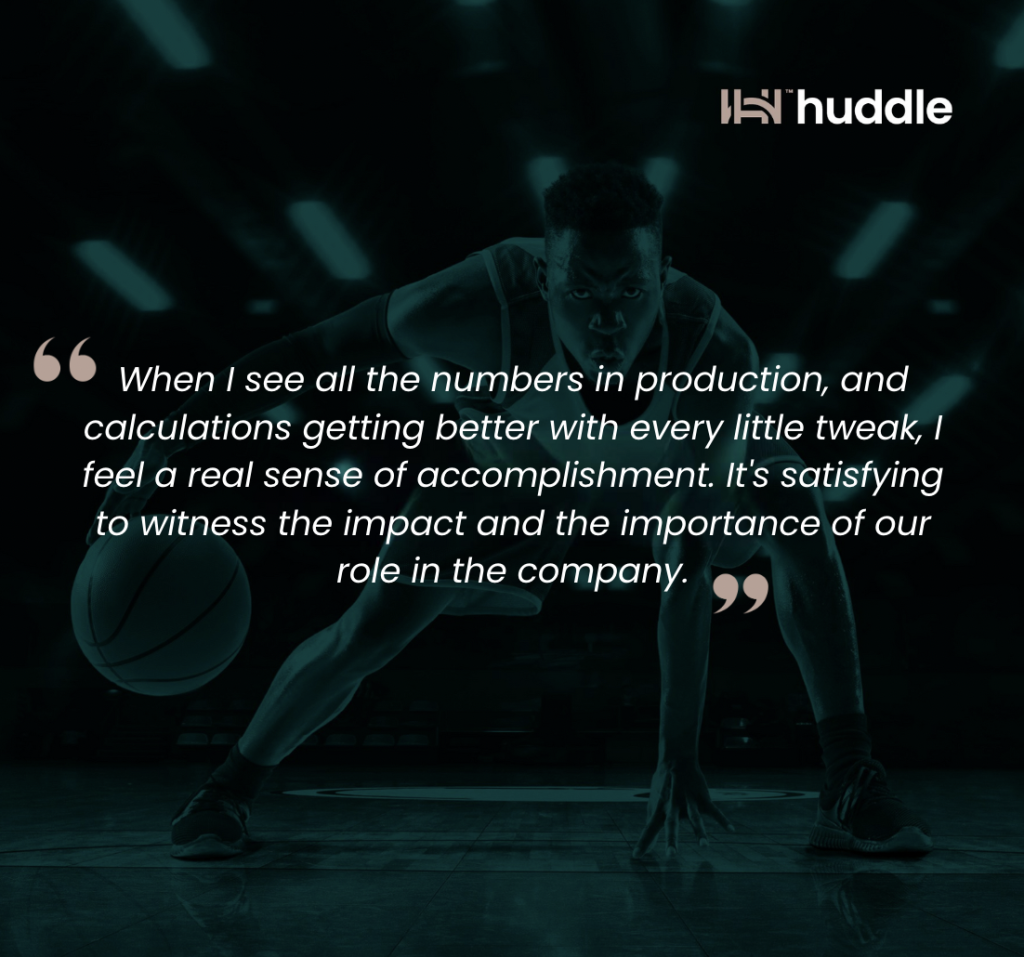
Meet The Team: Q&A with Huddle’s Quantitative Analyst, Maja Pucek
Blog
Meet The Team: Q&A with Huddle’s Quantitative Analyst, Maja Pucek
In this insightful Q&A, we sit down with Maja Pucek, a talented quantitative analyst at Huddle, to explore her journey and the pivotal role she plays in the world of sports betting. Maja shares her passion for mathematics and the logical challenges of quantitative analysis, which have driven her from university studies to her current role at Huddle. Through this Q&A, we gain a deeper understanding of Maja's role and the rewarding aspects of her work at Huddle
What initially drew you to the world of quantitative analysis in sports betting, and how has your passion for it evolved over time? You had a sports betting background even before joining Huddle. How did your previous experience prepare you for the work you do here at Huddle?
Maja: The shortest answer I can give you to that question is simply maths. I find quantitative analysis to be an exciting profession that presents new challenges every day, both logical and probabilistic. This drive, which I have carried since university, comes from a never-ending desire to learn and expand my knowledge. I love watching soccer games, particularly the World and European Cups. The thrill of the matches and the shared excitement have further fueled my interest in sports betting.
My sports betting journey started in 2021 when I joined Minus5. Fresh out of university, I went straight into a quantitative analyst role. We had a small team where we brainstormed every sport from scratch. During that time, I had the opportunity to work on various projects involving the development of predictive models and the analysis of sports-related patterns. I would say this experience greatly helped me understand how the betting industry works, the basic concepts of sports modeling, and the statistical methods crucial for the role.
Collaboration seems crucial in your role. How do you work with the Data Engineering team to ensure smooth integration of your models into Huddle's systems?
Maja: That's correct. The Data Engineering is very important to the Quantitative analysts. The data engineering team keeps all our important data safe and organized. They ensure everything is secure and easy to find, allowing us to focus on analyzing and developing models.
I would say that Huddle made a good division into teams, with the quants and data engineers being part of the same analytics group. We have the same lead/VP, Gabrielle, who ensures that all the processes between these two teams work smoothly. On a more granular level, we, as colleagues, solve day-to-day tasks very efficiently. We understand our individual roles and assist each other in defining tasks. For example, if the quants department needs historical data, we specify what data is needed and in what format, and collaborate to ensure it is accurately gathered and utilized. We, as quants, also develop data-driven models to analyze trends and make predictions. The data engineers then create pipelines to automate the deployment and operation of these models. These are just a few examples of how these two teams couldn't function without each other.

Can you share an example of a particularly successful implementation of a quantitative model that significantly improved Huddle's product/models?
Maja: The first one that comes to mind is the implementation of player props for the NBA, which was the first time we offered player markets at Huddle. That was definitely a major project in which we invested a lot of time and effort. I was heavily involved from the beginning when we brainstormed all the ideas on how we could implement this. We needed to revamp the main basketball model to adapt to players' behavior in every possible situation on the court.
On the other hand, we also developed a brand new algorithm that now runs every day. For this, we had to conduct a lot of player-specific historical analysis. I was pleased that in this process, I was able to apply many methods and knowledge from my probabilistic background from university. I used clustering methods to divide players into specific groups and other machine learning algorithms like regression and time series models to predict players' future behaviors. Once my model was in the final phase, it was handed over to the data engineers, who implemented a pipeline that runs on a daily or weekly basis. This project is another good example of the collaboration between the quant and data engineering teams.
Can you share a bit about a mentor or influential figure in your career at Huddle who has helped shape your approach to quantitative analysis in sports betting?
Maja: If I had to single out one mentor, it would certainly be Toni Ruscic. He has been my quant colleague since the first day I entered sports betting and we work together at Huddle . We both have similar backgrounds and interests from university and got along from the start. He is a sports expert, possessing an encyclopedic knowledge of various sports and their intricacies. From him, I learned every sport rule and logic that I didn’t know before. Throughout my quant journey, we have worked together on many quant problems, and his insightful perspectives on sports are invaluable in solving these problems. I would say that he has been instrumental in my onboarding as a quant, teaching me everything I need to know for my role.
You are the person behind Huddle’s popular Knowledge Hub piece called “By The Numbers”. What aspects of collaborating with the marketing team on the "By The Numbers" column do you find most fulfilling, and how do you perceive the impact of communicating data-driven insights about Huddle's performance through this platform?
Maja: Thank you for bringing that up as I am very happy to be a part of a piece that shares some of Huddle’s many successes and that can be read by anyone outside Huddle. I think that this piece is very innovative in the sports industry and it gives our marketing team a dose of refreshment.
This collaboration between analytics team and marketing team is very exciting. Together, we transform raw data into valuable information that drives business growth and success. This way we go out with well defined and verified numbers, not just empty talk.
To get to the finished publishable version, behind the scenes is a lot of work. Many brainstorming sessions where we together put our ideas. The marketing team had the base idea of what they wanted to show our potential customers/industry professionals, and what is important to show from the marketing perspective. From my side I provide them with detailed reports and visualisations. With those reports we together chose the most valuable ones and then we refine them so that they are easy to read and understand.
The whole process is interesting to me because it makes me feel like I'm part of the broader organizational goals. This also gives me the opportunity and challenge to show my statistical expertise on projects outside my usual scope of work. All in all, for me, it is truly rewarding to receive positive feedback on our Knowledge Hub, particularly when other companies engage with Huddle due to the impact of our efforts.
Looking back on your journey as a quantitative analyst at Huddle, what has been the most rewarding aspect of your role thus far?
Maja: I would say that the most rewarding aspect as a quantitative analyst at Huddle is developing and implementing innovative quantitative models to solve challenging problems. The whole process of identifying issues, testing models, and refining them to improve accuracy and efficiency are intellectually stimulating and rewarding. Later when I see all the numbers in production, and how the calculations get better with every little tweak I feel a real sense of accomplishment. It's satisfying to witness the impact and the importance of our role in the company.














